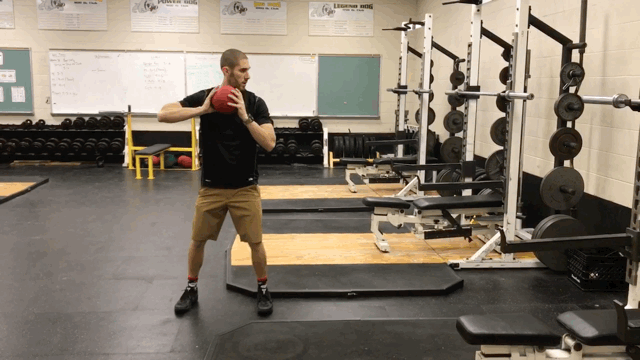“Core Training” – What It Is and How to Progress It – Part III

The previous two parts of this series discussed both the intro and intermediate phases of my own progressions for core/trunk training.
Part I specifically discussed what it actually means to train the “core” – or as we are calling it instead, the trunk – and how to build the foundation for more advanced training in subsequent phases. As you may recall, the goals of the first phase hinged on building strength and stability of the trunk through postural awareness and many static trunk stability exercises. Overall, Phase I focuses on teaching the athlete what it means to brace the trunk, find spinal neutral, and breathe correctly through all of this. Thus, Phase I is named “Basic Trunk Stability”.
Then, Part II covered the next step in the trunk training progression – taking that newly developed trunk stability and postural awareness, and further cementing it through more challenging and dynamic movement. This meant taking a progressive step from holding static postures against relatively static forces (i.e. gravity) seen in Phase I, and moving to a force absorption emphasis. In other words, learning to absorb varying and dynamic opposing forces. For these reasons, Phase II is dubbed “Dynamic Trunk Stability”.
Today we will discuss the final Phase of my philosophy on trunk training. This phase centers on taking the dynamic stability developed in Phase II and progressing it from force absorption capabilities to force expression potential. In other words, we train our athletes to use the trunk musculature to transfer and express forces for improved performance. In a baseball sense, this means transferring energy rotationally through the trunk. Thus, Phase III is named “Power/Speed” training for the trunk in my program.
As stated in the previous installments, this series aims to be informative and practical, thus brief context and explanations are given for eact phase and categories of movement, while plenty of exercise examples are given and illustrated.
PHASE III – POWER/SPEED TRAINING FOR THE TRUNK
Overview: once the goals of Phase I (static trunk stability, postural awareness, effective breathing, basic trunk musculature strength) and Phase II (further multi-planer strengthening, dynamic stability capabilities, force absorption ability) have been met, Phase III can then be initiated.
Phase III should not only incorporate the most ballistic, challenging, and complex exercises up until this point, but also the most sport-specific to enhance transfer to baseball/pitching. Thus, this phase should be the ultimate step in the off-season progression, culminating just prior to the pre-season/regular season.
Goals:
- Learn to sequence the kinetic chain to optimize production, transfer, and expression of power, while reducing the potential for “energy leakage” from breaks in the kinetic chain
- Learn to transfer energy through the trunk, and how to create separation of the hips and shoulders to do so
- Utilize the elastic properties of the muscles to enhance the output of energy
Duration: typically 4-8
The overall theme of this phase is to take the trunk stability gaimed durging the initial phase and the subsequent energy absorption/dynamic stability learned in Phase II, and use that to ensure safe execution of Phase III.
While Phase I and II can improve performance, they primarily serve to reduce the likelihood of injury both on the field and in training. By doing this, we know that we can safely progress to more advanced and ballistic movements, such as ones that mimic throwing/pitching/hitting, yet potentially with greater loads (such as that of a medicine ball).
Sample Exercises and Progressions:
Medicine Ball Slam (Core Stiffness) ->
Band Rotation ->
Medicine Ball Scoop Toss ->
Medicine Ball Rotational Throw ->
Medicine Ball Rotational Throw (w/ Walk In) ->
Medicine Ball Rotational Throw (w/ Plyo Ball ® Rebound) ->
Medicine Ball Caber Toss ->
Overall, the progressions in this phase tend to move in the following direction:
- From single movements to repeated repetitions
- From standard movements to xpxlyometricxx movements
Benchmarks: overall, the athlete should strive to produce, transfer, and express power efficiently, effectively, and intentionally. Above all else, the athlete should also be in peak physical condition, healthy, and injury-free at the conclusion of Phase III, as this culminates with the introduction of competition play.
***
After reading this three-part series, I hope that you, the amateur-level player or coach, have a better understanding of the “core” or trunk, its responsibility as a stabilizer of the spine and vehicle for energy transfer.
Also, this piece should help provide some kind of framework for training the trunk, and some examples of how to to go about doing so. While this isn’t the only way to view trunk training, it is one way to go about it, and one that should provide a safe and viable path through the off-season in preparation for the competition season.







Comment section